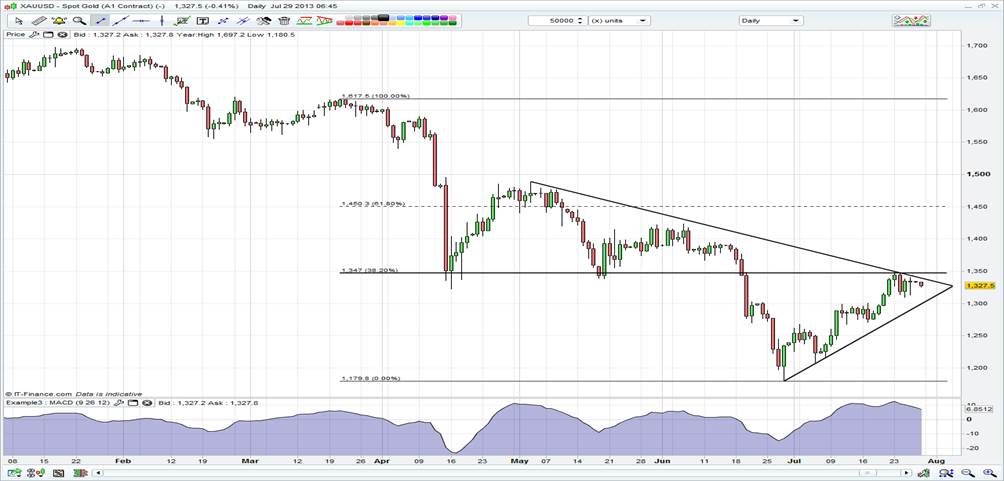Traders seem to be expecting a continuation of USD weakness this week, although we feel if this proves correct then it will be a short-lived view; we still feel the USD will be stronger over the medium term. With such a plethora of key data points and other macro events this week, you get the sense that volatility could come into the market after dying down a touch last week, although the short-term seems hard to predict.
It seems that investors and traders still want to be overweight global equities, and clearly this is being seen in the weekly fund flows. AMG reported another $3.3 billion being added to US equity funds last week, its twenty-ninth consecutive week of inflows; what’s more, 27 out those weeks have seen over $1 billion being added. Earnings have been OK, although the headline numbers around beats and misses have generally been around the average of past quarterly reports, and one would probably give the season a 6.5 out of 10 thus far. With most of the key bell-weather names having been and gone, it seems logical that Q2 earnings will gently slip from being the main focal point for traders, and top-down issues should become of greater significance this week.
We feel the market is probably going into the mid-week FOMC meeting in a more market neutral stance on the USD, while positive on equities given the US media has been hinting to a delay to tapering and the potential for a lowering in threshold expectations for both unemployment and inflation and the subsequent rise in the Fed funds rate. Given the fed funds future is now priced to see the first real move higher in rates in 2015, pricing suggests the market is positioned in a much more aligned manor, with the Fed themselves and thus yields on US bonds probably reflecting more fair value at current levels (2.56%). The other thing is the big pick-up in rhetoric around the next Fed chairman. With a large number of senate democrats appealing for Janet Yellen to get the post, this may have played into the USD weakness. However, selling USDs on the back of this seems quite premature at this stage, as the last three Fed chairman have all had close working relationships with the President, who ultimately gets to choose who is appointed. Thus, history would throw Larry Summers up as the favourite, which would be a USD positive.
Asia is not looking too flash at present, with the ASX up a whole four points, while China is down 2.7% and Japan also lower by 3.3%. The fact the ASX 200 has held up so well is positive, with financials and materials providing support. There have been a few interesting stock stories to focus on, with China’s Molybdenum buying an 80% stake in Rio’s Northparkes copper assets, while OZL has come out with further disappointing news for shareholders in writing down $200 to $240 million of asset value at its Prominent Hill mine. By all accounts OZL was also in the running for the Northparkes assets, and thus given the issues at Carapateena should have seen upside risks to its share price from the acquisition; the failure to capture this asset could be weighing as well. On the other side of the coin, Rio’s shareholders should welcome this (provided it goes through) as it should be seen as a compelling price and a nice boost for its balance sheet.
AUD/USD has traded in a range of 0.9247 to 0.9287, although currently sits at the top of that range. Speculation that the RBA may join the Fed, ECB, BoE, BoJ, Riksbank and Norges bank in providing longer-term guidance would be interesting and certainly welcomed by many in the equity, FX and fixed income markets. Clearly a move to explicit guidance towards future interest rate direction would be negative for the local unit, but a positive for bonds; however for the time being the RBA will continue with its loose guidance settings.
Japan continues to struggle, although had found buyers off the June uptrend and 38.2% retracement of the May sell-off at 13763, however the bears are in firm control right now and closed below this support. Further talk of delaying the much-anticipated increase to consumption tax in 2014 is hurting sentiment, as this would represent the first major back-track by the Abe government since it came into power. In theory this would provide continued spending power into the Japanese economy, although some may see the potential push back on the tax as a sign the economy is not strong enough to withstand the tax. Friday’s national June CPI seems to also be having some effect; while the headline print was strong (+0.4%), the increases (like in Europe) are all driven from higher energy prices. Domestic drivers and the sorts of inflation the BoJ is trying to boost, such as entertainment, housing, food and household goods are actually going backwards, so if ‘Abenomics’ was designed to boost inflation and subsequently revenues, then it isn’t materialising very fast and it begs the question, how long do markets give the BoJ?
Chinese traders are clearly nervous ahead of the debt review taking place across the country, and by all accounts will focus on debt levels as low as village level. We wait in anticipation of the results.
European markets look set to open a slightly firmer footing, despite weaker Asian markets and a slight downward move in FTSE and US futures through the day. Data is on the light side, with UK mortgage approvals in play, while on the earnings side we get numbers from Simon Property Group, Anadarko Petroleum and in Europe Danone.
